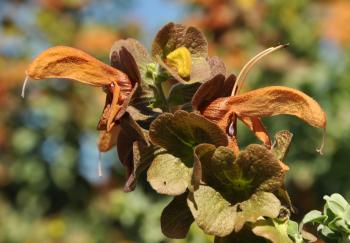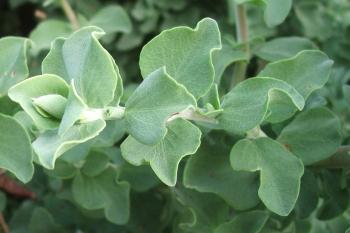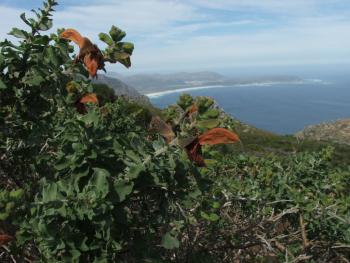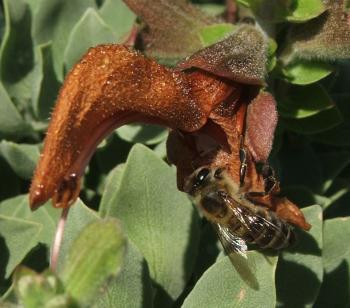Salvia aurea
Salvia aurea L. (= Salvia africana-lutea L.)
Family: Lamiaceae
Common names: golden sage, beach sage, dune sage, sand sage (Eng.); bruinsalie, sandsalie, strandsalie, geelblomsalie (Afr.)
Introduction
Salvia aurea is an aromatic hardy shrub with unusually coloured flowers borne over a long period. It is fairly fast-growing, up to 2 m, and very attractive to wildlife.

Description
Description
Flowering begins in early spring, and the bright yellow flowers soon fade to rusty-orange and then reddish brown. After the petals fall, the saucer-like calyx, which becomes papery with age, remains as an added attraction. The flowers are both attractive and a curiosity. I.C. Hedge (1974) says the flowers at maturity give the impression of being withered. He describes them as golden brown, often with a trace of purple at the base. The flowers are complemented by greyish-green, aromatic foliage. Altogether, this is a very worthwhile addition to one's garden.

Conservation Status
Status
According to the Red List of South African Plants, checked on 9 November 2015, the conservation status of Salvia aurea is Least Concern (LC).
Distribution and habitat
Distribution description
The distribution of S. aurea extends from the coast of Namaqualand to the Cape Peninsula and eastwards from there to Port Alfred. In its natural state it grows not far from the sea and is often a common constituent of the vegetation on coastal sand dunes.

Derivation of name and historical aspects
History
The name is derived from the Latin salvere meaning to save or heal, and refers to the medicinal properties of some species. The species name aurea means 'golden', and describes the yellow colour of the emerging flowers and the burnished golden-brown of the flowers.
This species has for many years been known as Salvia africana-lutea, however, according to the rules of botanical nomenclature, hyphenated names are illegitimate. The current or 'new' name was also given by Linnaeus a few years after he coined the original name, and is now the legitimate name. The first part of the old species name, africana, means 'of Africa' and describes the plant's origin and the second part, lutea, means 'golden'.
The sage family is a very large one characterized by square stems and aromatic leaves. Other popular plants of this family are mints, Hemizygia sp., and Orthosiphon sp. The common name "salie" is applied to many other trees and shrubs with sage-like leaves. Over 1 000 species of Salvia — consisting of annuals, perennials, biennials and shrubs — are found in all the warm temperate countries of the world. Of these, 38 are widely distributed in South Africa.
Ecology
Ecology
The flowers contain a lot of sweet nectar which attracts bees and moths, and acts as an essential food supply for sunbirds, particularly when proteas are not flowering.
A number of the blue and bronze groups of butterflies use salvias as larval host plants. Salvia's method of pollination is quite crafty: hidden in the hood of the flower is a clever lever mechanism of the stamens; when an insect crawls in at the mouth of the flower, looking for nectar in the flower base, its head pushes against a sterile part of the stamen, which pushes the anther downwards and rubs some of the pollen off onto the insect's back. When the stigma is mature, it bends down and blocks the way of the insect visiting the flower. If some pollen of another flower is already on the insect's back, it rubs off against the stigma and results in cross-pollination. However, if you take a closer look at the flowers of Salvia aurea you will see that they are too big for a bee, so that when a bee feeds on the nectar the stamens do not touch its back. This is because this sage has shifted its pollinator from bees to nectar-feeding birds, and these flowers are now designed to touch the visiting bird on its head.

Uses
Use
Apart from attracting wildlife, Salvia aurea makes an excellent tea for coughs, colds, bronchitis and 'female' ailments — pour 1 cup of boiling water over a short (70 mm) sprig of leaves, stand for 5 minutes then strain and drink sweetened with honey. The leaves are lovely for use in potpourri as they retain their shape, colour and much of their fragrance, and mix well with other ingredients.

Growing Salvia aurea
Grow
This is an excellent choice for coastal gardens, as it prefers light, well-drained soil and full sun, tolerates strong winds, and is drought resistant. It has been cultivated successfully further inland and upcountry, as it is capable of resprouting from its rootstock it recovers suitably from frost damage, but preferably try to find it a warm sheltered spot in the garden if you live in a frosty area. For more prolific growth, water well and give it plenty of compost/mulch. Some pruning should be done to keep the plant shapely, but with age, usually after about five years or more, a build-up of wood is inevitable. At this point it is better to start afresh with a young plant. Brown salvia is easily propagated by stem cuttings, or seed sown in spring. Seedlings will flower from a year to 18 months after sowing.
This salvia makes a fine rockery plant and the grey-brown effect of its foliage and flowers makes a pleasing contrast to the more usual green vegetation of the garden. It is also suitable for an informal shrub border. It's useful to plant a mixture of summer and winter flowering salvia species with the taller species at the back and shorter species in front. This way one can have flowers all year round, keeping the butterflies, bees, sunbirds and white-eyes captive in your garden.
References
- ELIOVSON, S. 1955. Wild flowers of South Africa, edn 6.
- ROBERTS, M. 1990. Indigenous healing plants. Southern Book Publishers.
- The Naturalist. 1981. Vol. 25, Part 3. Eastern Province Branch of the SA Wildlife Society.
- JOFFE, P. 1993. The gardener's guide to South African plants. Cape Town, Tafelburg Publishers.
- The Flowering Plants of Africa. 1965/1966. Vol. 37.
Credits
Cherise Viljoen
Kirstenbosch National Botanical Garden
July 2002
Updated by Alice Notten
Kirstenbosch National Botanical Garden
November 2015 and February 2019
Plant Attributes:
Plant Type: Shrub
SA Distribution: Eastern Cape, Northern Cape, Western Cape
Soil type: Sandy, Clay, Loam
Flowering season: Spring, Early Summer, Autumn, Winter, Sporadic/All year
PH: Acid, Neutral
Flower colour: Brown, Yellow, Orange
Aspect: Full Sun
Gardening skill: Easy
Special Features:
Horticultural zones










Rate this article
Article well written and informative
Rate this plant
Is this an interesting plant?
Login to add your Comment
Back to topNot registered yet? Click here to register.